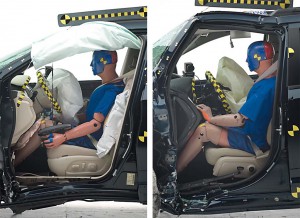Only three of the seven midsize SUVs scored well in a series of front-end crash tests designed to simulate real-world accidents.
And only one of the 2015 models, the Nissan Murano, earned the coveted Top Safety Pick Plus rating from the Insurance Institute for Highway Safety, though the Ford Flex and Jeep Wrangler also passed the small overlap crash test designed to simulate what happens when a vehicle’s corner clips another car or a utility pole.
The test has posed some serious challenges for manufacturers and has led to a number of vehicle redesigns since it was first used in 2012. In the small overlap test, 25% of a vehicle’s front end strikes a barrier at 40 mph.
“The designation of the IIHS ‘Top Safety Pick Plus’ for the all-new 2015 Murano is exactly what Nissan expected for a vehicle that has always set the trends in its segment,” said Fred Diaz, a Nissan senior vice president, in a statement. “This Murano has once again raised the bar for midsize crossovers.”
(11 Google autonomous vehicles involved in “minor” crashes. Click Here for the latest,)
The Murano received a “good” rating in the small overlap test, the highest the IIHS offers. But it also is equipped with a forward collision mitigation system that can both detect a potential crash and, if necessary, apply the brakes automatically. That is one of the requirements for a Top Safety Pick Plus rating.
The boxy Ford Flex, which does not offer a crash mitigation system, had to settle for a Top Safety Pick endorsement. It was rated “acceptable” in the small overlap test.
The third vehicle to pass the test was the Jeep Wrangler, but the SUV did not get a Top Safety Pick rating because it scored only “marginal” in side and rear crash tests, the IIHS noted.
Another vehicle made by Fiat Chrysler was the worst performer in the small overlap test. According to the IIHS, the passenger compartment of the 2015 Dodge Journey partially collapsed, the side airbag failed to inflate, and the parking brake pedal tore through the crash dummy’s left lower leg. That earned the 2015 Journey a “poor” rating.
The maker tried to put the poor showing in a more positive light, declaring that, “No single test determines overall, real-world vehicle safety.” In a statement, the maker added that, “every FCA US vehicle meets or exceeds all applicable federal motor-vehicle safety standards.”
But IIHS Chief Research Officer David Zuby was less upbeat, in his own statement cautioning that “Chrysler, Dodge and Jeep have had some successes with redesigned models, but they haven’t done much in the way of interim improvements. As a result, they still have many models that rate poor or marginal.”
(FCA appeals $150 mil verdict in Jeep fire death. Click Here for the story.)
While the Jeep Cherokee and Dodge Durango fared better than the Dodge Journey in the latest round of tests, they still got only a “marginal” rating. So did the Hyundai Santa Fe.
Including midsize models that were previously tested, the worst performer in the midsize SUV/CUV category was the Mazda CX-9. In previous testing of nine midsize models from the 2014 model-year, the Toyota Highlander earned a Top Safety Pick Plus rating. Four other models earned Top Safety Pick rankings: the Chevrolet Equinox and GMC Terrain, as well as the Kia Sorento and Nissan Pathfinder.
(Backers hope recall crisis will help push Do-Not-Rent bill through Congress. Click Here for more.)



The problem with this test is that a change of one degree in impact angle can change the results dramatically. There in lies the problem because we really don’t know if the test results are representative of real accidents or not. If they are then redesigning the vehicles may help. If they are not then a lot of time and money will be spent chasing a specific test parameter and not occupant safety.
I guess hiring all of those highly educated engineers from countries where they cannot drive is working very well for the “big whatever”. Perhaps that’s why it now costs 10x and takes 3x the amount of time to design a car. Having “human resources” hire automotive designers definitely has not saved any money.